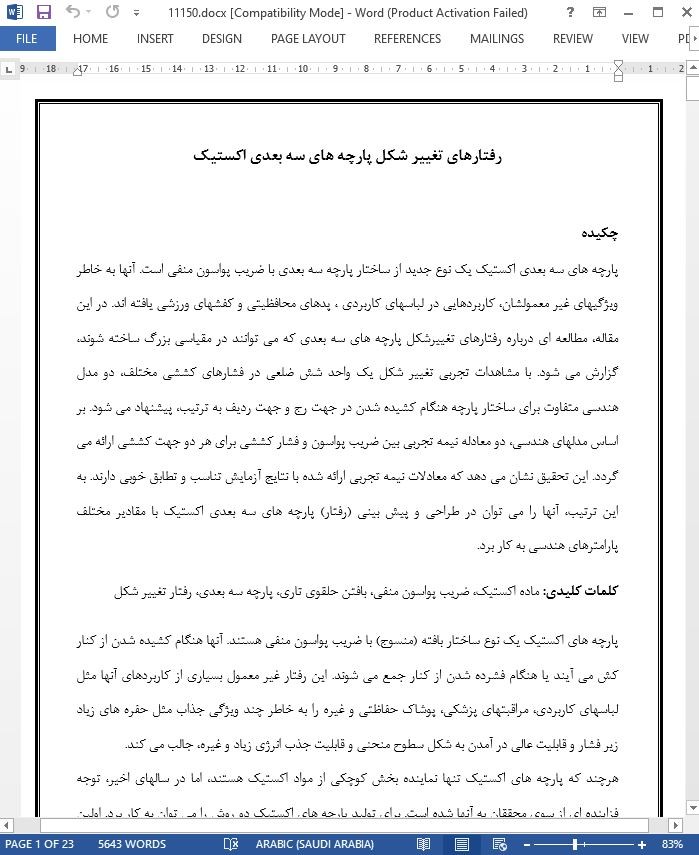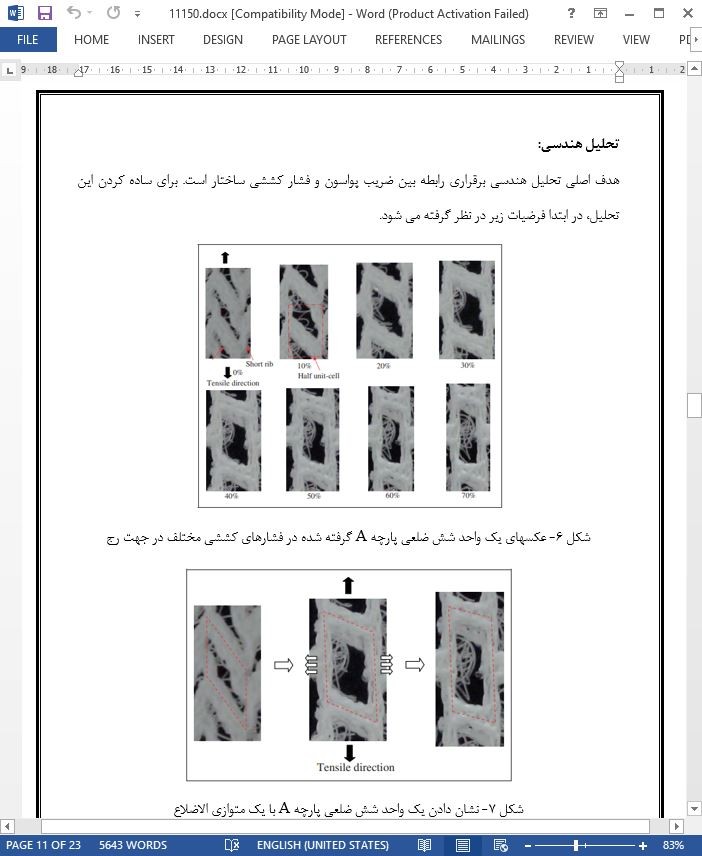
رفتارهای تغییر شکل پارچه های سه بعدی اکستیک
چکیده
پارچه های سه بعدی اکستیک یک نوع جدید از ساختار پارچه سه بعدی با ضریب پواسون منفی است. آنها به خاطر ویژگیهای غیر معمولشان، کاربردهایی در لباسهای کاربردی ، پدهای محافظیتی و کفشهای ورزشی یافته اند. در این مقاله، مطالعه ای درباره رفتارهای تغییرشکل پارچه های سه بعدی که می توانند در مقیاسی بزرگ ساخته شوند، گزارش می شود. با مشاهدات تجربی تغییر شکل یک واحد شش ضلعی در فشارهای کششی مختلف، دو مدل هندسی متفاوت برای ساختار پارچه هنگام کشیده شدن در جهت رج و جهت ردیف به ترتیب، پیشنهاد می شود. بر اساس مدلهای هندسی، دو معادله نیمه تجربی بین ضریب پواسون و فشار کششی برای هر دو جهت کششی ارائه می گردد. این تحقیق نشان می دهد که معادلات نیمه تجربی ارائه شده با نتایج آزمایش تناسب و تطابق خوبی دارند. به این ترتیب، آنها را می توان در طراحی و پیش بینی (رفتار) پارچه های سه بعدی اکستیک با مقادیر مختلف پارامترهای هندسی به کار برد.
پارچه های اکستیک یک نوع ساختار بافته (منسوج) با ضریب پواسون منفی هستند. آنها هنگام کشیده شدن از کنار کش می آیند یا هنگام فشرده شدن از کنار جمع می شوند. این رفتار غیر معمول بسیاری از کاربردهای آنها مثل لباسهای کاربردی، مراقبتهای پزشکی، پوشاک حفاظتی و غیره را به خاطر چند ویژگی جذاب مثل حفره های زیاد زیر فشار و قابلیت عالی در آمدن به شکل سطوح منحنی و قابلیت جذب انرژی زیاد و غیره، جالب می کند.
نتیجه گیری
رفتارهای تغییر شکل ساختار پارچه سه بعدی اکستیک در هر دو جهت رج و ردیف بر اساس مشاهدات تجربی یک واحد شش ضلعی و تحلیل نظری مدلهای هندسی پیشنهادی مورد مطالعه قرار گرفتند. معادله نیمه تجربی بین ضریب پواسون و فشار کششی برای هر جهت کششی (جداگانه) ارائه شد. چند نتیجه را می توان از این تحقیق استخراج نمود.
1- به خاطر رفتار ناهمگون ساختار اکستیک سه بعدی، مدلهای هندسی مختلفی برای تحلیل رفتارهای تغییر شکل ساختار در جهت های کششی مختلف مورد نیازند. در حالی که تغییر شکل واحد شش ضلعی در جهت رج را می توان با تغییر شکل یک متوازی الاضلاع نشان داد، تغییر شکل واحد شش ضلعی در جهت ردیف همیشه به شکل شش ضلعی حفظ می شود.
Abstract
Auxetic spacer fabrics are a novel kind of three-dimensional (3D) fabric structure with a negative Poisson’s ratio. They have found a number of applications in functional garments, protective pads and sportive shoes due to their unusual properties. In this paper, a study on deformation behaviors of 3D spacer fabrics that could be fabricated on a large scale is reported. Through experimental observations of deformation of a basic hexagonal unit at different tensile strains, two different geometrical models are proposed for the fabric structure when extended in the course direction and wale direction, respectively. Based on the geometrical models, two semi-empirical equations between the Poisson’s ratio and tensile strain are established for both tensile directions. The study shows that the established semi-empirical equations fit well with experimental results. Therefore, they could be used in the design and prediction of 3D auxetic spacer fabrics with different values of geometrical parameters.
Auxetic fabrics are a kind of textile structure with a negative Poisson’s ratio (PR).1,2 They laterally expand when stretched or laterally shrink when compressed. This unusual behavior makes them very interesting in many applications, such as functional garments, health care, protective clothing and so on, due to a number of fascinating properties, such as enhanced porosity under extension, excellent formability to curved surfaces, high energy absorption ability, etc.2
Conclusions
The deformation behaviors of 3D auxetic spacer fabric structure in both the course and wale directions were studied based on the experimental observations of a hexagonal unit and theoretical analysis of geometrical models proposed. The semi-empirical equation between the PR and tensile strain was established for each tensile direction. Some conclusions could be drawn from the study.
1. Due to the anisotropic behavior of the 3D auxetic structure, different geometrical models are needed for analyzing deformation behaviors of the structure in different tensile directions. While the deformation of the hexagonal unit in the course direction can be represented by deformation of a parallelogram, the deformation of the hexagonal unit in the wale direction always keeps in a hexagonal form.
چکیده
جزئیات تجربی
طراحی و تولید پارچه
آزمونهای کششی
نتایج و بحث
رفتار تغییر شکل هنگام کشیده شدن در جهت رج
رفتار تغییر شکل هنگام کشیده شدن در جهت ردیف
نتیجه گیری
Abstract
Experimental details
Fabric design and fabrication
Tensile tests
Results and discussion
Deformation behavior when extended in the course direction
Deformation behavior when extended in the wale direction
Conclusions
- ترجمه فارسی مقاله با فرمت ورد (word) با قابلیت ویرایش، بدون آرم سایت ای ترجمه
- ترجمه فارسی مقاله با فرمت pdf، بدون آرم سایت ای ترجمه



